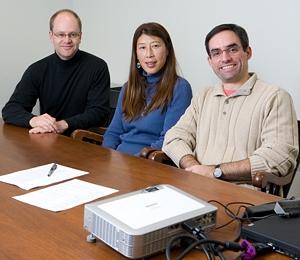November 20, 2009
A member of the college’s information technology department and two faculty colleagues are hoping that a new tutor will be able to provide answers to many of the questions that learners of Chinese, Spanish and Portuguese may have.
One caveat: The tutor, as Director of Academic Technology Services Scott Payne puts it, “isn’t a carbon-based form of intelligence. It’s a silicon-based one.”
 Scott Payne, left, with Weija Li and Luiz Amaral |
Said “tutor” is an instant-messenger (IM) computer program that enables students to have queries about various foreign languages answered real-time, online. The tool, dubbed LangBot, operates as a human IM “buddy” would, though exponentially faster; it searches various language Web sites and a specially developed corpus of language and responds with answers. When a user typed in “what is the word for tree in German?” for example, LangBot replied with “baum,” along with several other terms, almost instantaneously.
Payne—who is collaborating with Weijia Li, senior lecturer in Chinese and director of Amherst’s Chinese language program, and Luiz Amaral, assistant professor of Hispanic linguistics at the University of Massachusetts, to build the program—said LangBot offers users a host of other valuable information in addition to simple translation. It provides examples of words or phrases in context; corrective feedback on spelling and grammar errors in sentences produced by the students; automatically-generated, individualized vocabulary tests; and ideas for level-appropriate readings in online newspapers. LangBot can even initiate interactions with students and make “word of the day” suggestions, Payne said.
What’s more, the tool adjusts to the skills, knowledge and learning curve of users, and tracks and maps their vocabulary development over time.
“What you have here is the computer as legitimate partner in the language acquisition process,” noted Payne. “It’s learning as more than just an exchange between two people.”
He and his collaborators hope that LangBot’s use of IM—a technology all too familiar to current college-age learners—will make it that much more effective as a resource. “Students today are on IM all the time,” he explained. “It’s something they’re comfortable with, something they use constantly. It speaks their language—pun intended—so it’s a great program to incorporate into the learning process.” He added that LangBot’s assessment data and quiz results offer those same users—who are accustomed to the immediacy and interactivity that growing up with the Internet has afforded them—an up-to-the-minute sense of what areas of their vocabulary they need to improve on and where they need focus their studies.
Although the program is still only in its beta stage, LangBot recently received an important national endorsement in the form of a three-year, $221,000 grant from the Department of Education’s International Research and Studies Program. The funding will enable the team to continue work on the program and eventually test it on the Amherst campus, possibly next fall.
In the meantime, Payne and his colleagues are working to add other languages to the program’s repertoire with an eye to one day rolling it out to other colleges and universities or any IM user.
“My feeling is that LangBot is a tool that complements traditional teaching methods really well,” said Payne. “It won’t ever replace a living, breathing teacher, classroom conversations or labs, because those are all critical elements of the language learning process. It simply serves a different purpose that helps achieve the same goal—developing competent communicators in foreign languages.”